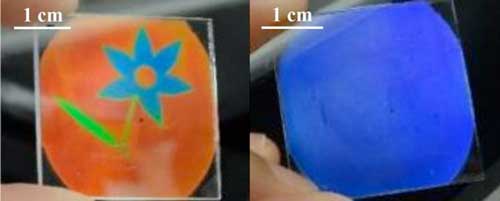| Posted: Feb 07, 2018 |
Printable, colorful camouflage with polymers
(Nanowerk News) In nature, colors can serve as a form of communication, but they can also hide animals and plants, camouflaging them from sight. Researchers now report in ACS Applied Materials & Interfaces ("Full Color Camouflage in a Printable Photonic Blue-Colored Polymer") that they have developed polymers that can better mimic nature's color-changing abilities than existing polymers. They say the materials could enable smart decorations, camouflage textiles and improved anti-counterfeiting measures.
|
 |
| Newly developed polymer can better mimic nature's color-changing abilities. (Image: American Chemical Society)
|
|
Most of the colors that people are familiar with, such as hues on a piece of paper, are made with pigments. But another type, called structural color, exists, in which the color is produced by periodically arranged microscopic structures that interfere with visible light.
|
|
For example, peacock tail feathers are actually brown, but microscopic structures present in the feathers make them look blue and green to the naked eye. Scientists have used cholesteric liquid-crystalline (CLC) polymers to mimic the structural coloration found in nature because they can easily be made into responsive materials. But so far, researchers have only produced them in a limited range of colors. So Albertus P. H. J. Schenning and Monali Moirangthem wanted to make CLC polymers with the full visible spectrum of colors.
|
|
The team used inkjet printing technology and a calcium nitrate solution to print an image on a CLC polymer they developed. Printing successive layers changed the degree of swelling of the CLC polymer, changing the color. One layer resulted in an orange color, a second layer changed it to green, and a third layer made it blue.
|
|
As an example, the researchers used the method to draw a blue flower with green leaves on a reddish-orange background. After the ink dried, the image was no longer visible--the entire surface appeared blue. However, sprinkling water or breathing on it caused the full color image to re-appear.
|

